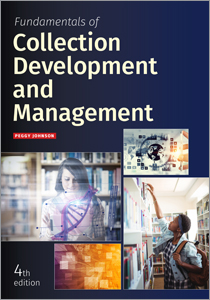
Johnson, Peggy. Fundamentals of Collection Development and Management. Fourth Edition. ALA Editions, 2018. ISBN: 978-0-8389-1641-4
Description
An essential textbook on the topic of collection development and management, this new edition has been revised and freshened to ensure its timeliness and continued excellence. Each chapter offers complete coverage of one aspect of collection development and management, including numerous suggestions for further reading and narrative case studies exploring the issues.
Table of Contents
1 Introduction to Collection Development and Management
- Components of Collection Development and Management
- Historical Overview
- Theories of Selection
- Future of Collection Development and Management
- Notes
- Suggested Readings
- Collection Management and Development Responsibilities
- Assignment of Responsibilities
- Skills and Competencies
- Learning after School
- Organizational Models
- Ethical Issues
- Notes
- Suggested Readings
- Planning in Libraries
- Planning Models
- Environmental Scanning
- Why Undertake Formal Planning?
- Collection Development Policy Statements
- Writing the Collection Development Policy Statement
- Budgeting and Finance
- Notes
- Suggested Readings
- Universe of Published Materials
- The Selection Process
- Notes
- Suggested Readings
- Overview
- Vendor Relations
- Negotiation
- Contracts
- Notes
- Suggested Readings
- Weeding
- Storage
- Preservation and Conservation
- Review and Cancellation of Continuing Resources
- Collection Protection and Security
- Notes
- Suggested Readings
- Understanding Marketing
- Marketing Concepts
- Managing the Marketing Cycle
- Liaison and Outreach Activities
- Social Media
- Notes
- Suggested Readings
- Collection Analysis as a Management Tool
- Historical Overview of Collection Analysis
- Approaches to Collection Analysis
- Electronic Resources and Collection Analysis
- Methods of Collection-Based Analysis
- Methods of Use- and User-Centered Analysis
- Cost-Benefit Analysis, Social Return on Investment, and Balanced Scorecards
- Conducting the Analysis and Preparing a Collection Analysis Report
- Notes
- Suggested Readings
- Overview
- Resource Sharing
- Bibliographic Access
- Coordinated or Collaborative Collection Building and Management
- Infrastructures for Cooperative and Collaborative Collection Development and Management
- Attributes of Successful Consortia
- Challenges to Collaborative Collection Development and Management
- Evaluating Collaborative and Cooperative Collection Development and Management
- Notes
- Suggested Readings
Appendix B Selection Aids
Glossary











